Smoked Pork Butt
Food: Smoked pork butt
Temperature: 225-250°
Cooking time: 12:00
Wood used: Apple
Notes: Cooked using minion method to start charcoal, then basted several times
I really want to cook a brisket in the coming weeks, and I felt that a pork shoulder or pork butt would be a good stepping stone for a long cook like the brisket. There’s less risk, obviously, in a $16 butt than a $60 brisket, so if I’m going to mess things up, it’s preferable to do it with a shoulder or butt. Previously, I’ve only done shorter smokes, using a chicken or ribs. Also, it’s worth noting — since many people don’t realize this — that the pork shoulder and butt are not the same thing, nor is the butt from the rear of the pig.
For reference, I used the recipes included with this post by Chris Allingham on his blog, The Virtual Weber. If you haven’t seen his site, I’d recommend checking it out. There’s a wealth of information there. He and Malcolm Reed (How to BBQ Right) are probably my favorite resources for both instruction and inspiration.
Preparation and Rub
To prepare the meat, I made a fairly simple rub (salt, pepper, garlic, paprika, Turbinado sugar, cayenne pepper) and set out to trim some of the fat off the butt. There’s a fat cap on the top of the butt and I’ve read mixed guidance on whether you should trim it off or leave it, with a lot of folks saying that it doesn’t make sense to apply rub to the fat since you’re only going to discard it anyway, and the rub can’t penetrate the meat below it prior to cooking. I’ve also read that the old myth of a fat cap flavoring the meat is just that, a myth, meaning there’s little reason to leave that much fat on the butt anyway.1 I did later find a video about trimming the butt that suggests that you cut an opening under the fat cap so that you can apply rub directly to the meat under it, but this still means you’re throwing away quite a bit of that amazing bark that develops.
Here’s the recipe for the rub, from the Virtual Weber blog post:
- 1/4 cup ground black pepper
- 1/4 cup paprika
- 1/4 cup Turbinado sugar
- 2 Tablespoons table salt
- 2 teaspoons dry mustard
- 1 teaspoon cayenne pepper
Ultimately, I trimmed probably between a half and three quarters of a pound of fat away, then applied the rub and put the bagged pork butt in the refrigerator to sit overnight.
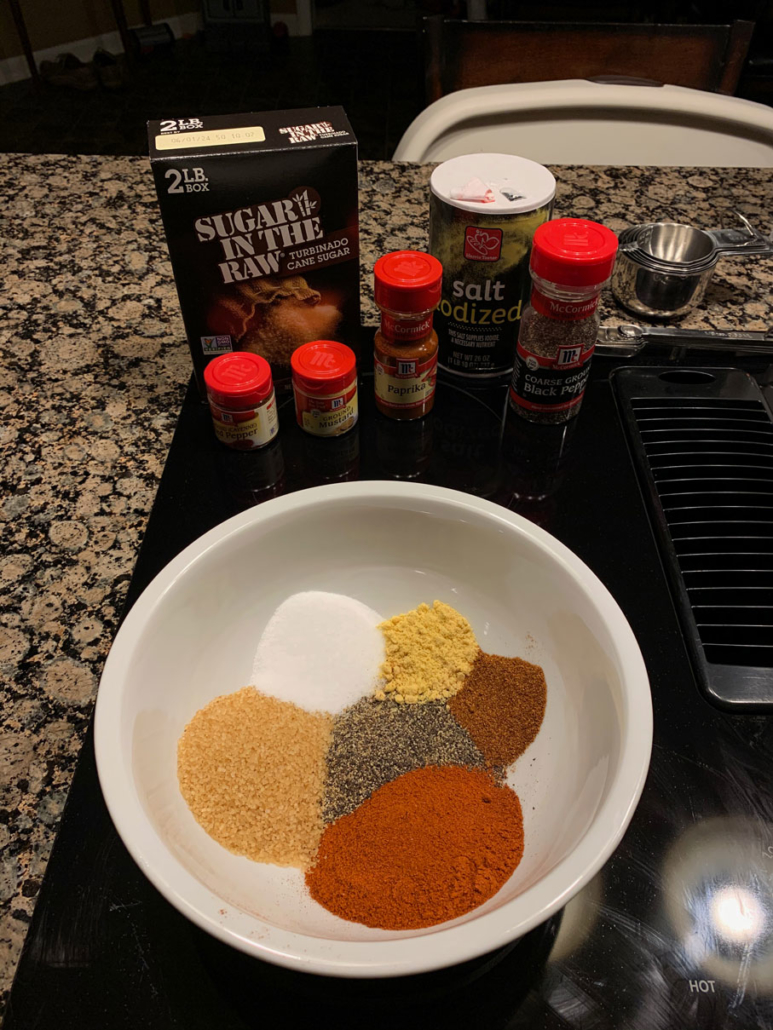
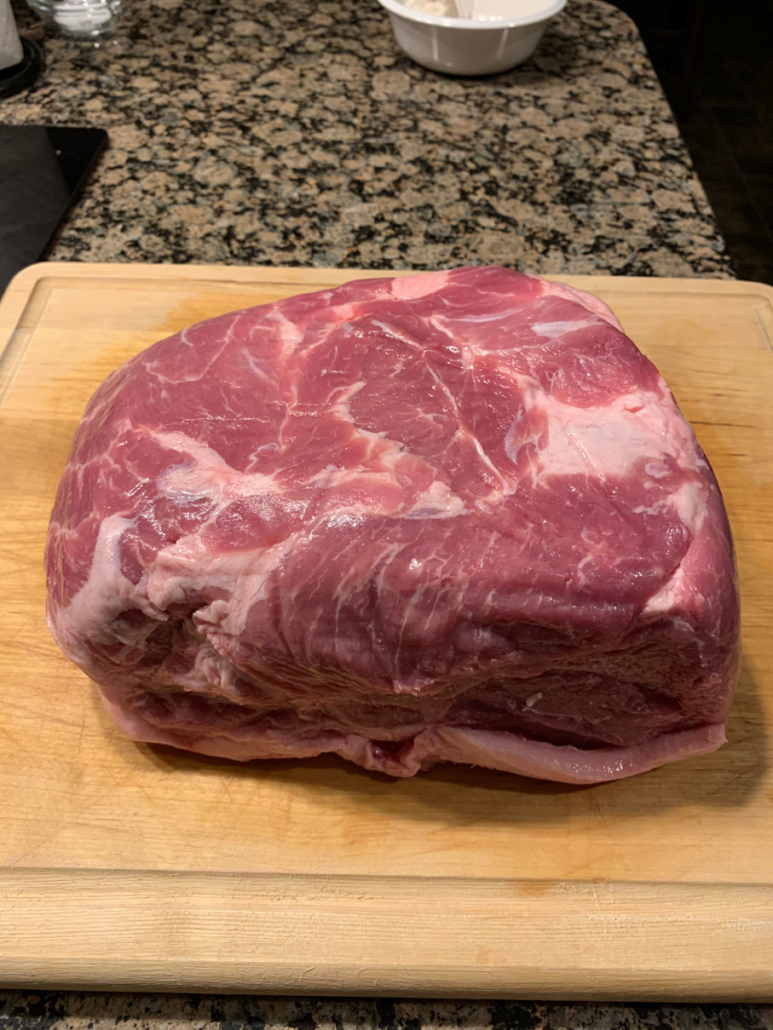
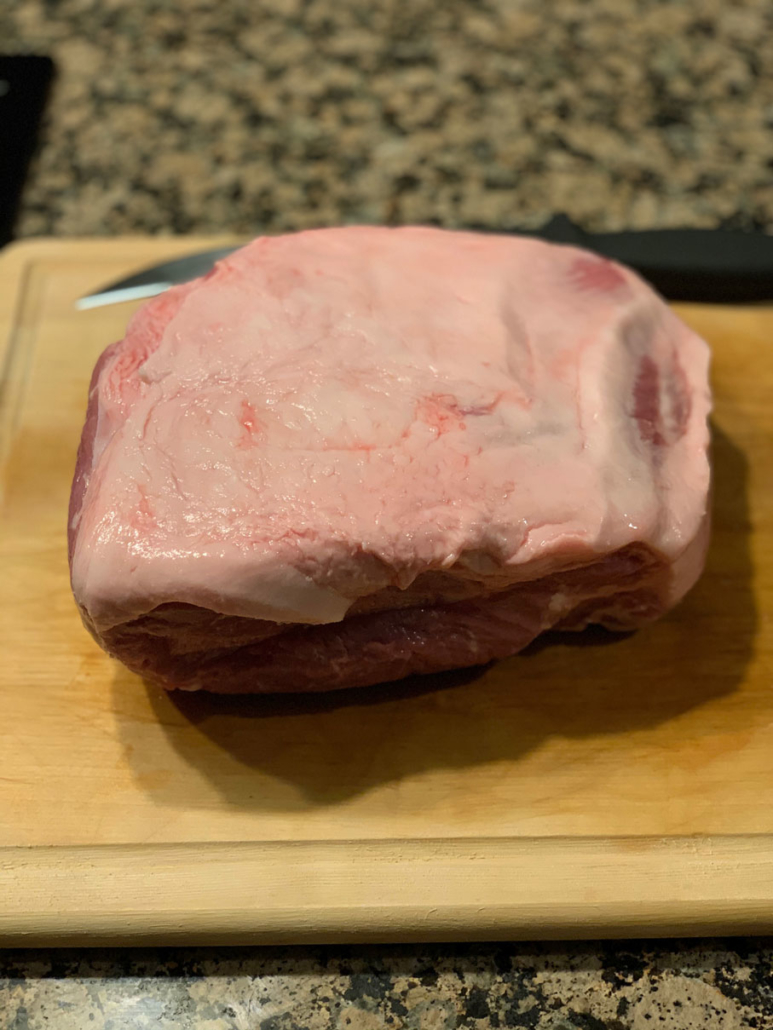

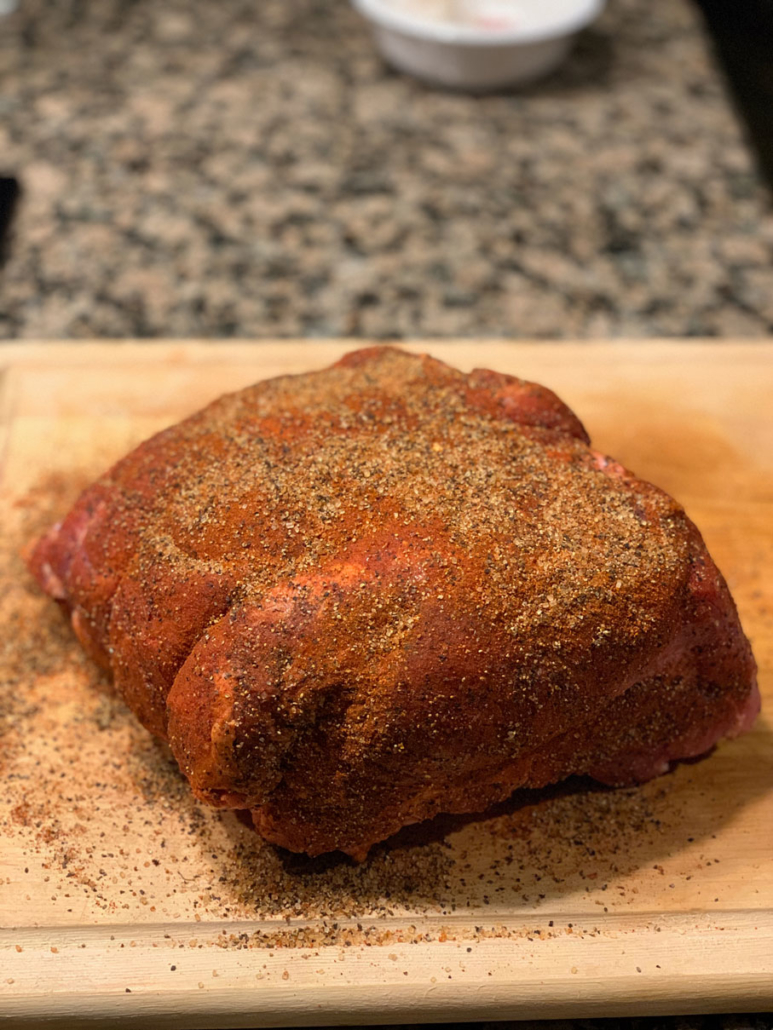
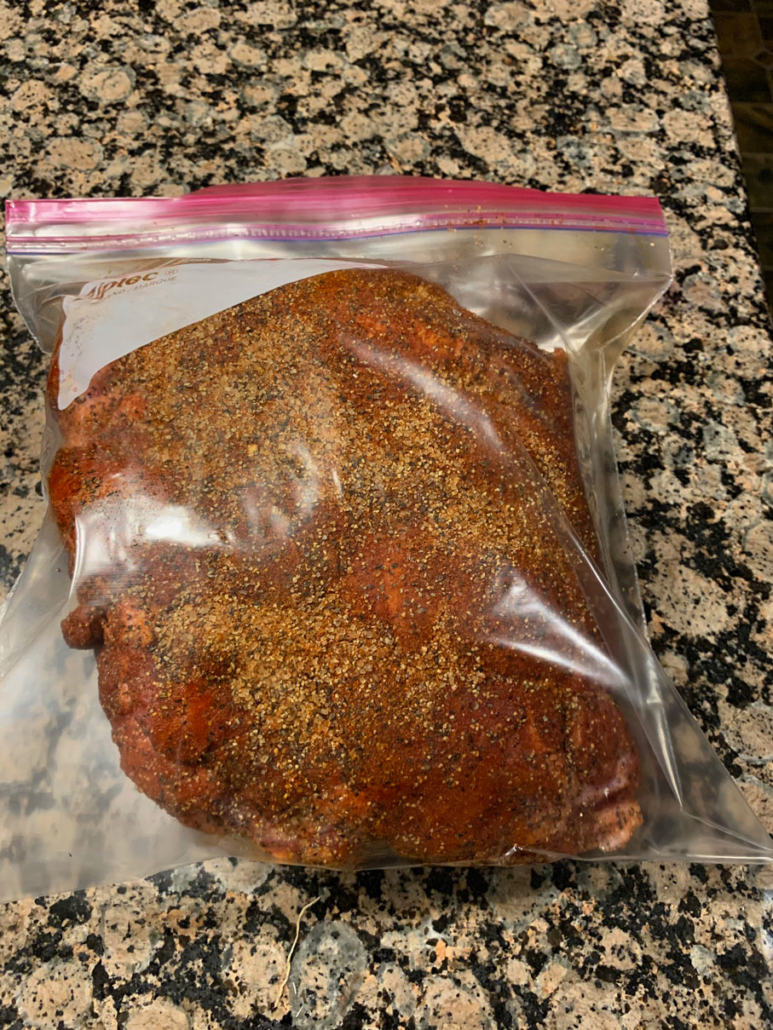
Firing Up the Smoker
Getting up at 6:00 AM to set up the cooker was not as bad as I thought. I have two small children (5yo son, 19mo daughter) and being outside in the nice cold air with a hot cup of coffee and absolutely no noise was pretty spectacular. Getting set up is quick and easy on the WSM. I loaded the bottom with charcoal and a half-dozen pieces of apple wood, then started a partial chimney of charcoals to pour on top of those.
I use water in the water bowl — this is an ongoing debate in the smoker community — mostly because (a) Weber knows how to build smokers and they included a water bowl and (b) the water bowl is intended to have water in it.
Once the charcoal was going, I put the smoker back together, opening the bottom vents fully, then added the meat and inserted a probe on the grill grate and a second one into the pork butt. I did, however, forget to open the top vent at first. This is the second time I’ve done this and I realized it after about 30 minutes. I don’t think it makes a huge difference this early in the cook, but I caught it fairly early on so not too stressed about it.

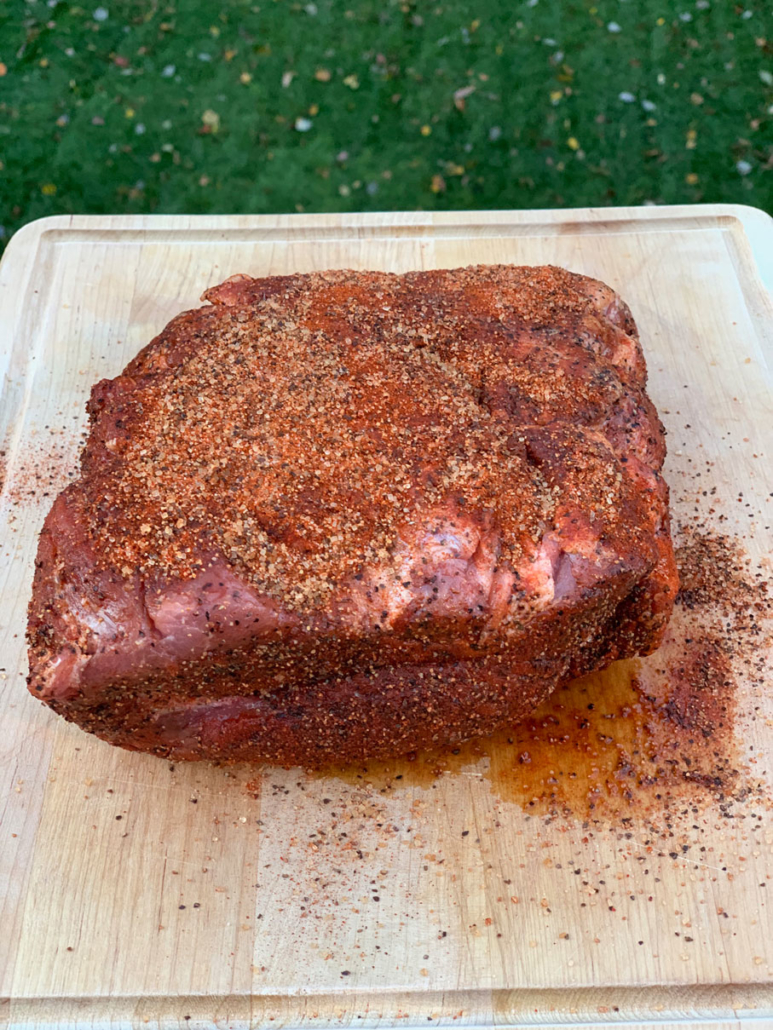
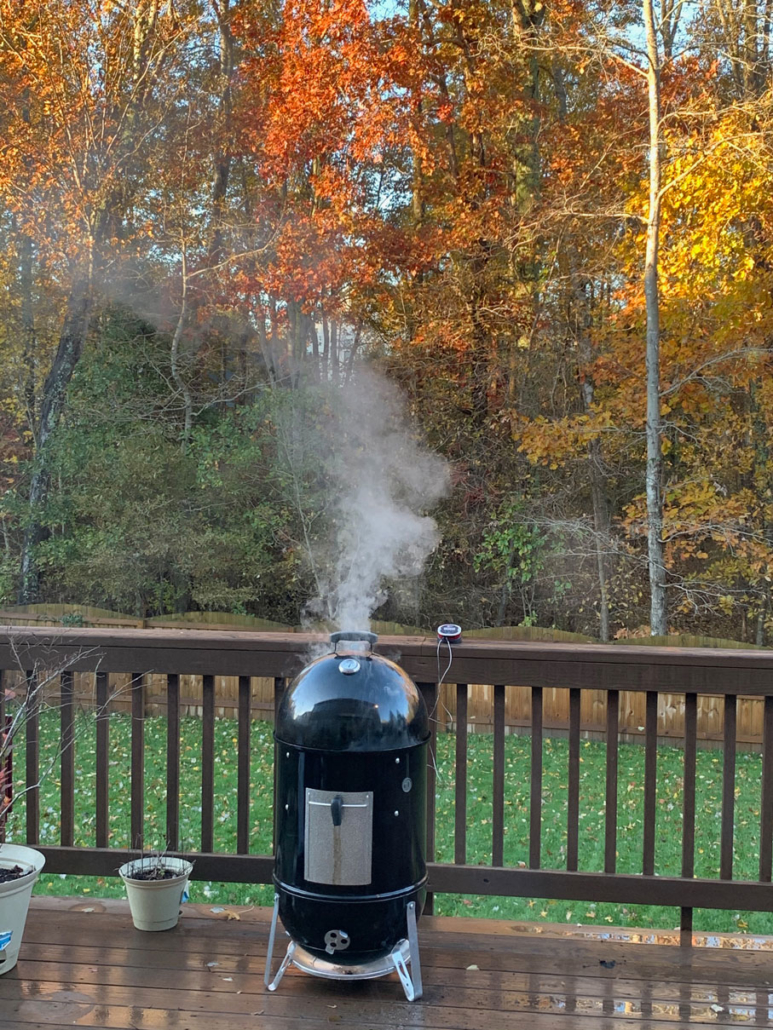
For the basting sauce, I used the recipe exactly as it appears on The Virtual Weber post:
- Remaining rub
- 2 cups apple cider vinegar
- 1 cup water
- 3 Tablespoons ground black pepper
- 2 Tablespoons table salt
- 1 Tablespoon Worcestershire sauce
- 1 Tablespoon paprika
- 1 Tablespoon cayenne pepper
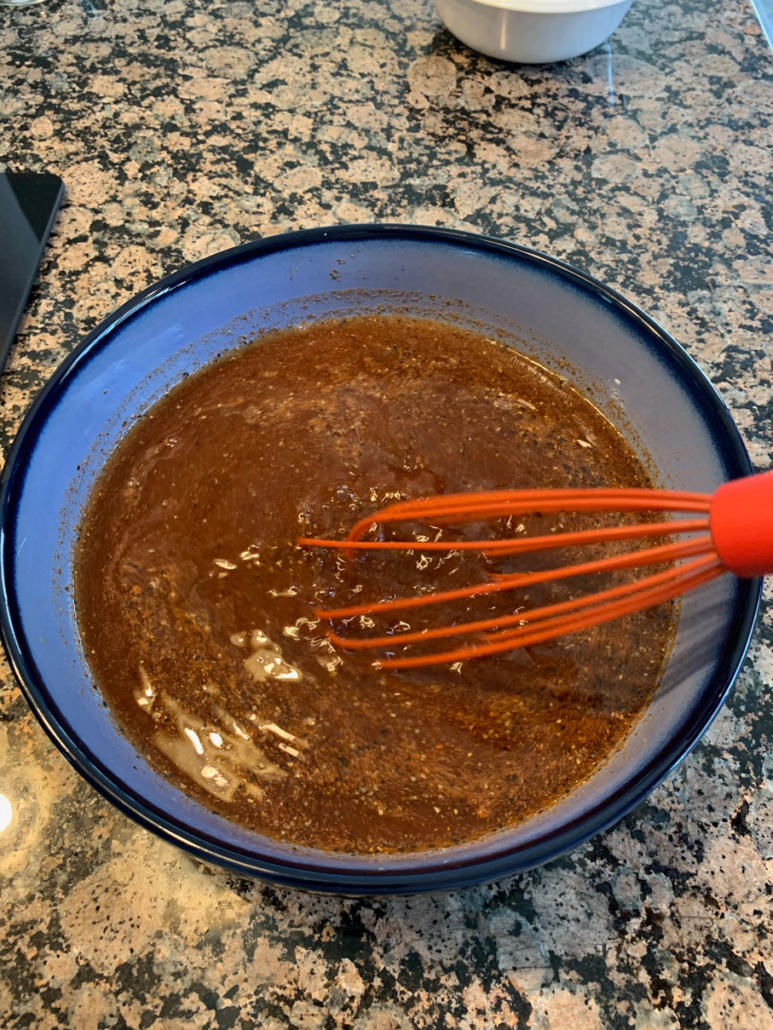
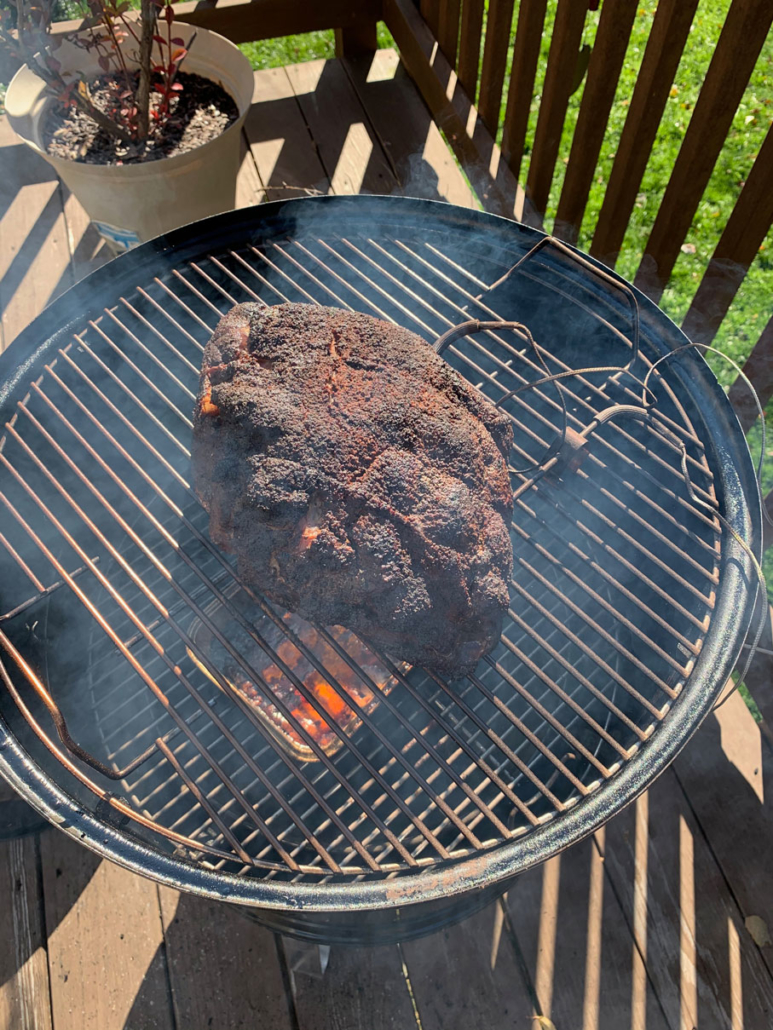

Cooking Log
| Time | Grill Temp | Meat Temp | Air Temp | Vents | Notes |
| 7:10 AM | 150 | 42 | 44 | 100% | Meat on, smoke on (apple wood, 5 pieces) |
| 7:30 AM | 202 | 43 | 44 | 100% | |
| 8:00 AM | 239 | 58 | 46 | 25% | Closed bottom vents to 25% |
| 8:30 AM | 251 | 89 | 46 | 20% | Closed vents to 20% to stop temp rise |
| 9:00 AM | 236 | 109 | 46 | 20% | |
| 9:30 AM | 234 | 126 | 48 | 20% | |
| 10:00 AM | 224 | 138 | 48 | 20% | |
| 10:30 AM | 218 | 147 | 50 | 25% | Stirred charcoal slightly |
| 11:00 AM | 238 | 152 | 51 | 25% | |
| 11:30 AM | 247 | 156 | 51 | 25% | Made baste sauce |
| 12:00 PM | 245 | 159 | 52 | 25% | Basted meat, stirred charcoal, added 3 pieces wood |
| 12:30 PM | 240 | 162 | 53 | 25% | |
| 1:00 PM | 248 | 165 | 53 | 25% | |
| 1:30 PM | 256 | 167 | 53 | 20% | |
| 2:00 PM | 230 | 171 | 55 | 20% | |
| 2:30 PM | 223 | 172 | 55 | 20% | Stirred coals |
| 3:00 PM | 250 | 174 | 56 | 25% | |
| 3:15 PM | 252 | 175 | 56 | 25% | Basted meat |
| 3:30 PM | 230 | 177 | 55 | 20% | Added charcoal, added 3 pieces wood |
| 4:00 PM | 249 | 180 | 55 | 20% | |
| 4:30 PM | 244 | 186 | 54 | 50% | |
| 5:00 PM | 239 | 192 | 52 | 100% | Opened vents to push meat temp up, stirred charcoal |
| 5:30 PM | 281 | 195 | 51 | 25% | Closed vents to control temp rise |
| 6:00 PM | 242 | 200 | 49 | 50% | Tweaked vents to keep heat at at least 250 |
| 6:30 PM | 273 | 203 | 49 | 20% | |
| 6:40 PM | 271 | 205 | 47 | 20% | Hit target temperature, probe inserts effortlessly |
Resting and Pulling the Pork
By 7:00 PM, I had the meat wrapped tightly in a double layer of tin foil and resting on a towel in a medium-sized cooler. I opened the cooler at 8:00 PM to vent the heat and let it continue resting until 9:00 PM. I really wish I had taken internal temperature readings at these two points, but I forgot to do so.
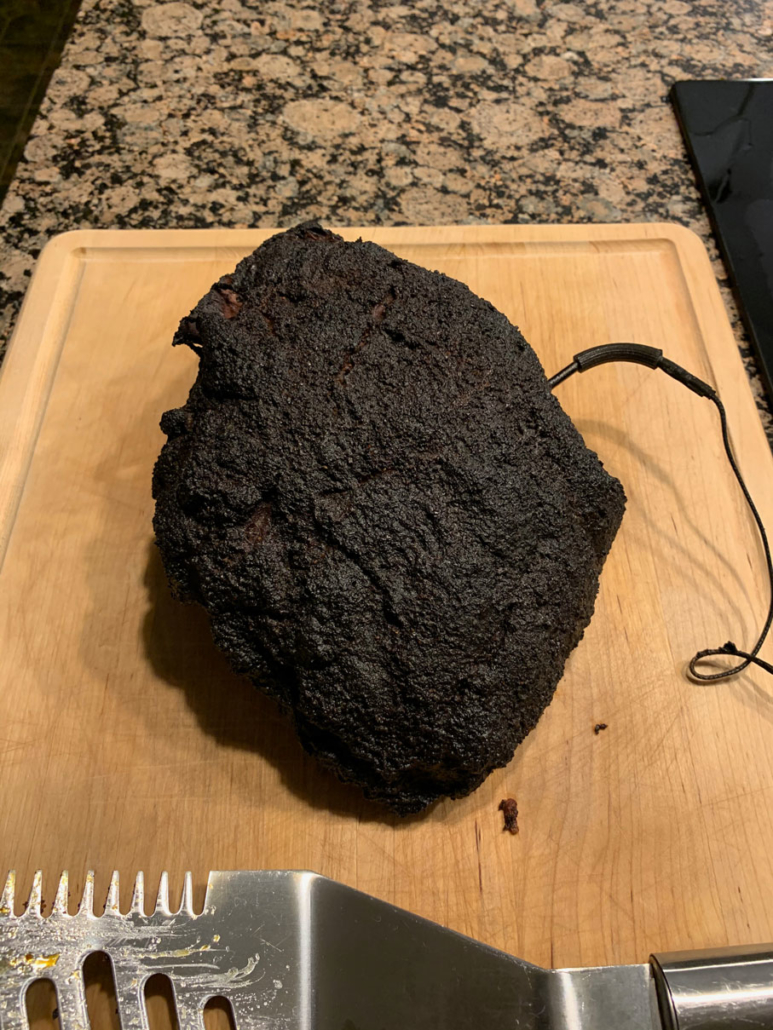

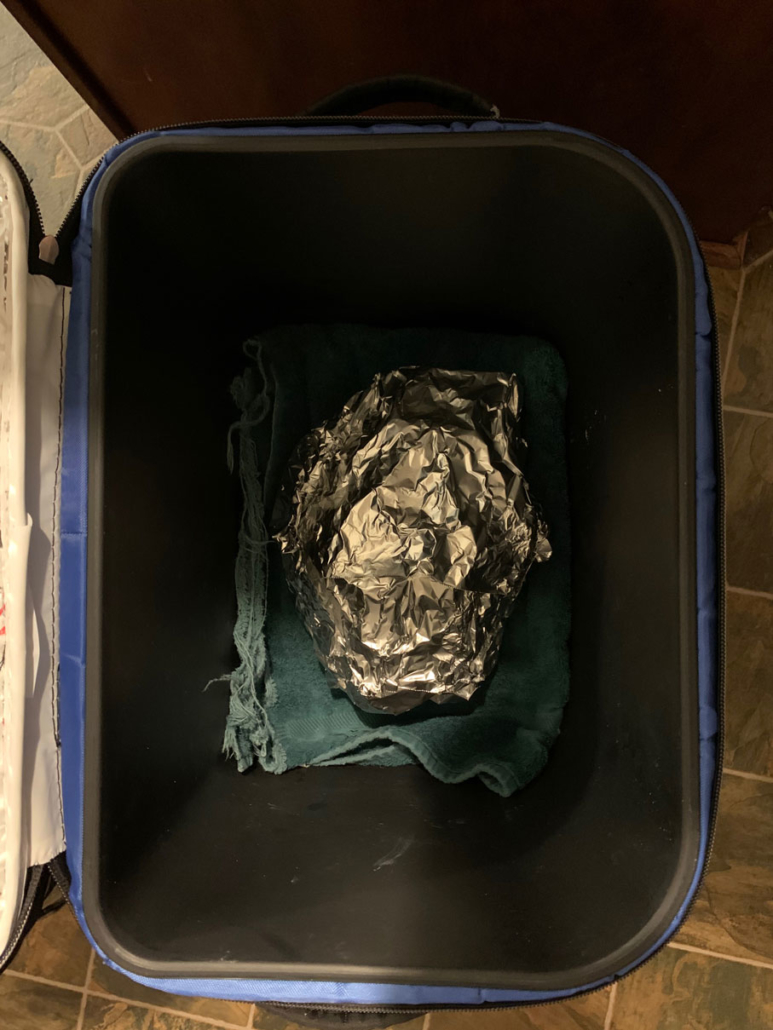
At 9:00 PM, I removed the pork butt from the cooler and pulled the meat apart. The bone came out easily, as I’d read should be expected. To tear the pork apart, we have a set of Bear Claws, but I never needed them. It just came apart easily in my hands, and pulling the entire pork butt apart only took a few minutes. Since the meat was still hot, I used nitrite gloves with cotton liners under them so that I could pull the meat more easily.

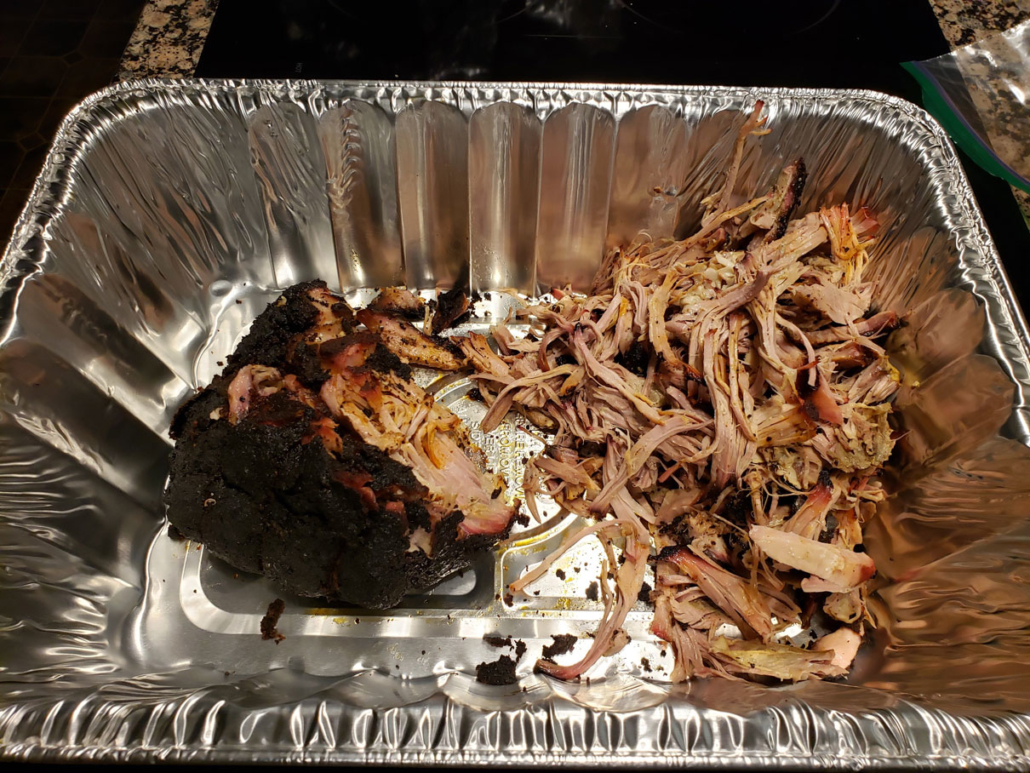
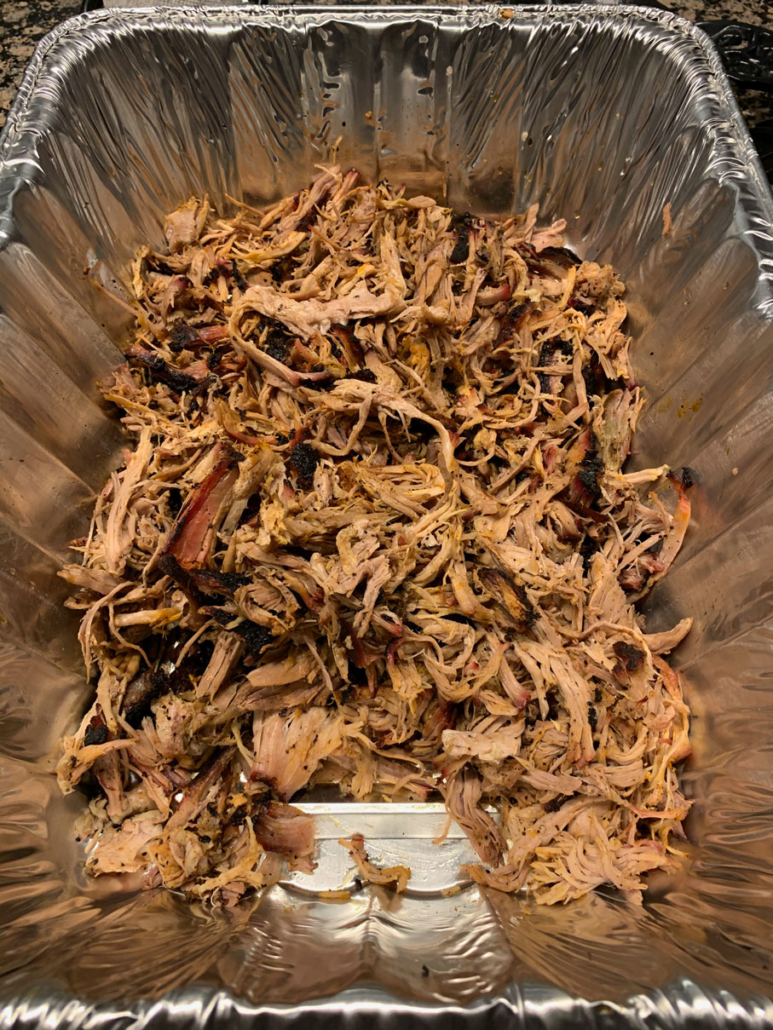
A couple more observations: I bought a 15 x 11″ tin pan (it’s Thanksgiving week, they’re on sale) and that was way more pan that needed for one piece of meat. I ended up putting all of the meat into a couple of Tupperware containers instead. Also, the basting sauce recipe makes way too much sauce. I would probably use a quarter of the ingredients for a single butt next time. Finally, the rub was great and I loved it, but it was perhaps too spicy for my kids. As a result, I tried to limit how much bark went onto their sandwiches, and they did eat it, but they’re missing out on some of the best parts that way.
Going into this, I wasn’t sure how long the cook would take. I had read that 5-8 hours was pretty normal, but a lot of people also said that theirs went more like 8-12 hours, so I was hoping to have this for dinner but we bought a backup meal in case it went longer, which it did. The next evening, we made sandwiches with toasted buns and pickles. I also made a Carolina barbecue sauce (vinegar, ketchup, etc.) to wet it with. This was perfect and it was still great after reheating it.
Carolina Red Barbecue Sauce
Here’s the recipe for the Carolina Red Barbecue sauce from The Virtual Weber:
- 1-1/2 cups apple cider vinegar
- 1/2 cup ketchup
- 1/2 teaspoon cayenne or red pepper flakes
- 1 Tablespoon sugar
- 1 teaspoon table salt
What’s most important, is that this cook gave me the confidence to be fairly comfortable with longer cooks now. Having some data to review, I’m a little less nervous about doing an overnight cook, and with a full brisket potentially taking 12-15 hours, I’d much rather let it cook overnight than try to stay awake with it.
I think I’m ready for that brisket now.









